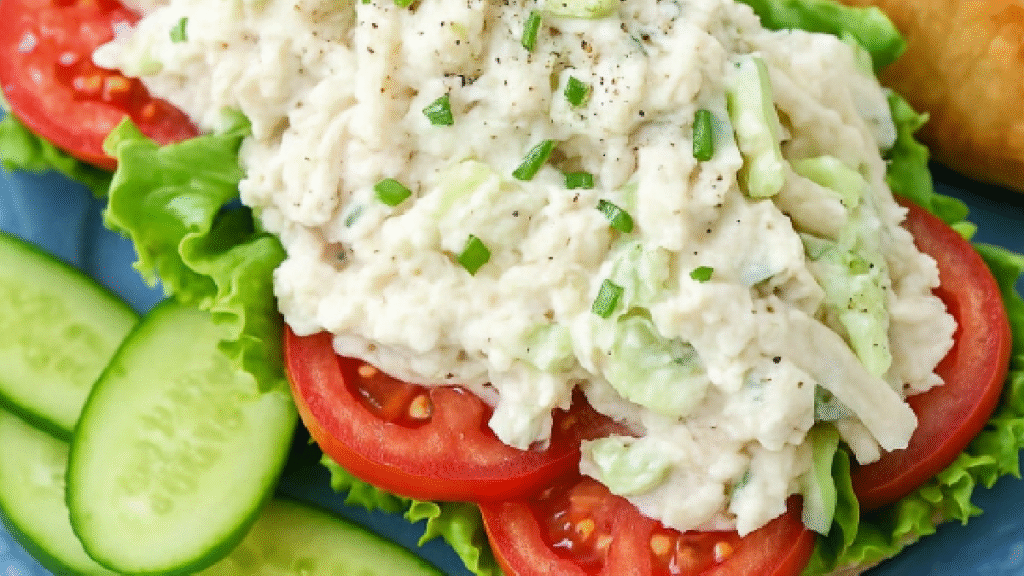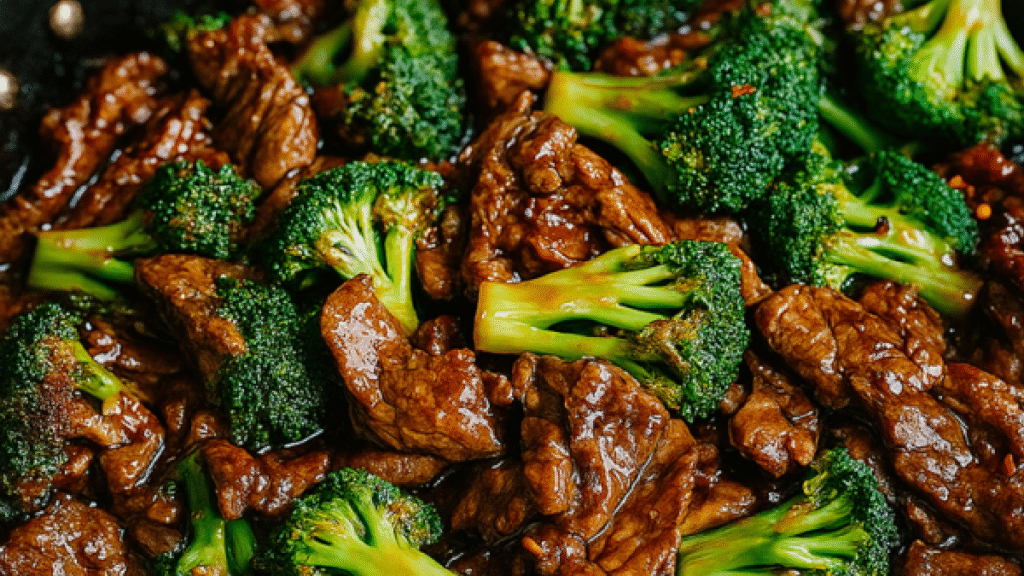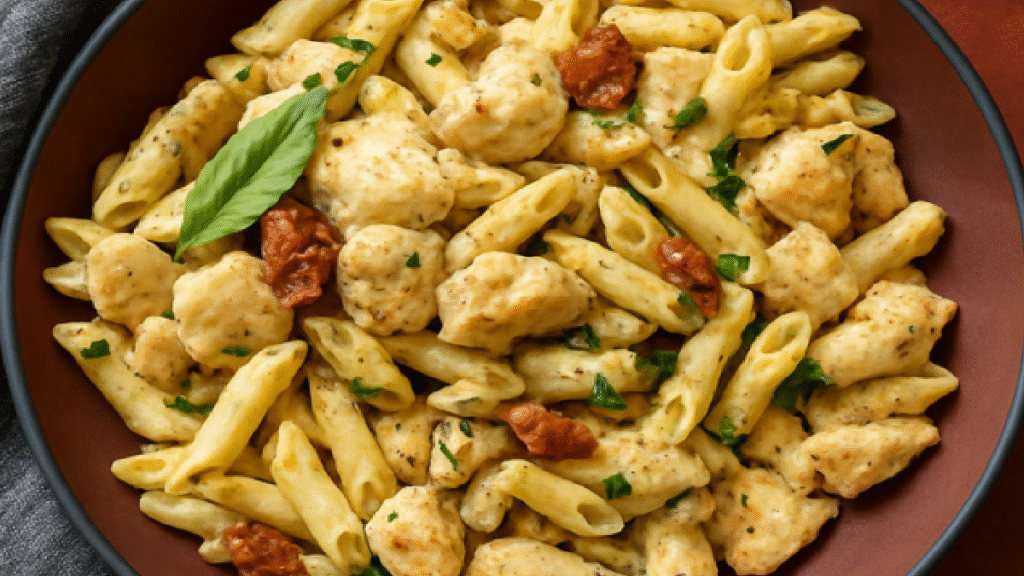A delicious and easy-to-make dish, this Classic Chicken Salad is perfect for a quick lunch or dinner. It’s a timeless favorite that never goes out of style.
One of my personal favorites, this chicken salad recipe is versatile and can be served in various ways. You can enjoy it on its own or paired with other dishes, such as our Marry Me Chicken Pasta, for a satisfying meal.
Key Takeaways
- Easy to prepare and delicious
- Versatile serving options
- Perfect for quick meals
- A classic dish that remains popular
- Can be paired with other recipes for variety
The Rich History of Chicken Salad
Tracing the origins of chicken salad reveals a fascinating journey through culinary history. Chicken salad, a dish enjoyed worldwide, has its roots in traditional European cuisine, particularly in France, and has evolved significantly over time.
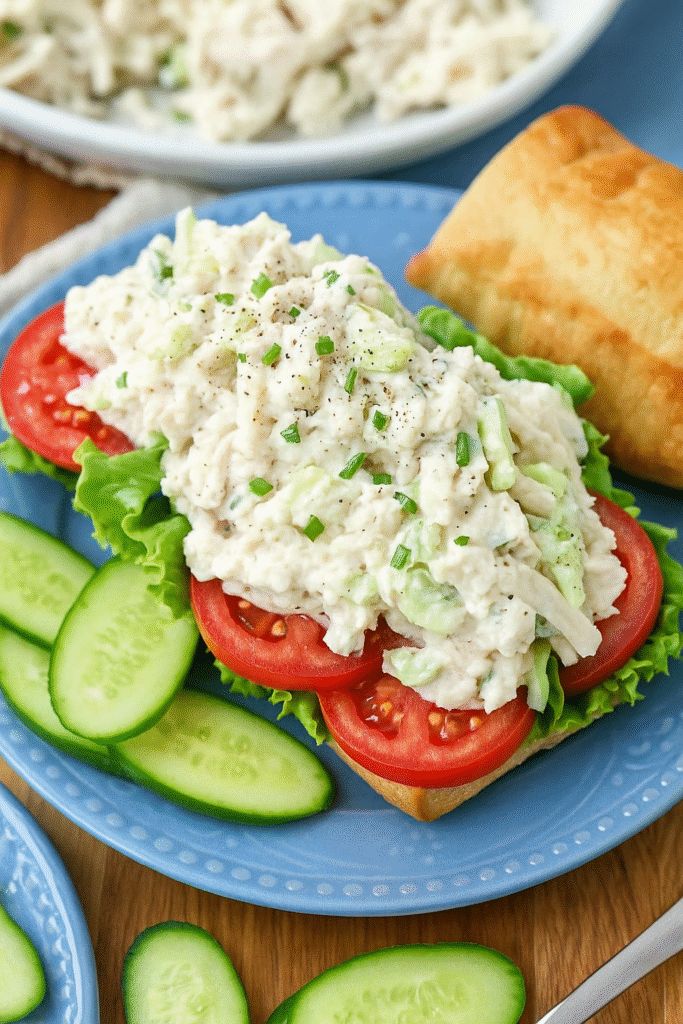
Origins in European Cuisine
European cuisine, known for its rich flavors and intricate preparations, laid the groundwork for chicken salad. The early versions were simple, combining cooked chicken with local herbs and vegetables.
Early French Interpretations
French cuisine, renowned for its sophistication, played a pivotal role in the early development of chicken salad. French chefs were among the first to mix cooked chicken with herbs, vegetables, and sometimes fruit, creating a dish that was both elegant and satisfying.
Transition to Modern Forms
As culinary techniques and global influences evolved, chicken salad transitioned into various modern forms. The incorporation of new ingredients and cooking methods transformed it into the diverse dish we know today.
Evolution in American Culinary Tradition
The introduction of chicken salad to America marked a significant turning point in its evolution. American culinary tradition embraced chicken salad, adapting it to local tastes and ingredients. The use of tender, juicy chicken became a hallmark of American-style chicken salad, often mixed with mayonnaise, herbs, and sometimes nuts or fruit. For more on how traditional dishes evolve, visit this page on goulash, a dish that, like chicken salad, has undergone significant transformations.
The evolution of chicken salad in America not only reflected the country’s melting pot culture but also its penchant for innovation in cuisine. Today, chicken salad remains a beloved dish, with countless variations across the globe.
Essential Ingredients for the Perfect Chicken Salad
A delicious chicken salad is built upon a few crucial elements. The foundation of a great chicken salad lies in its essential ingredients, which include the type of chicken used, the freshness of the produce, and the choice of dressing and seasoning.
Selecting the Right Chicken
Choosing the right chicken is paramount. The decision between free-range and conventional chicken can significantly impact the flavor and quality of the salad.
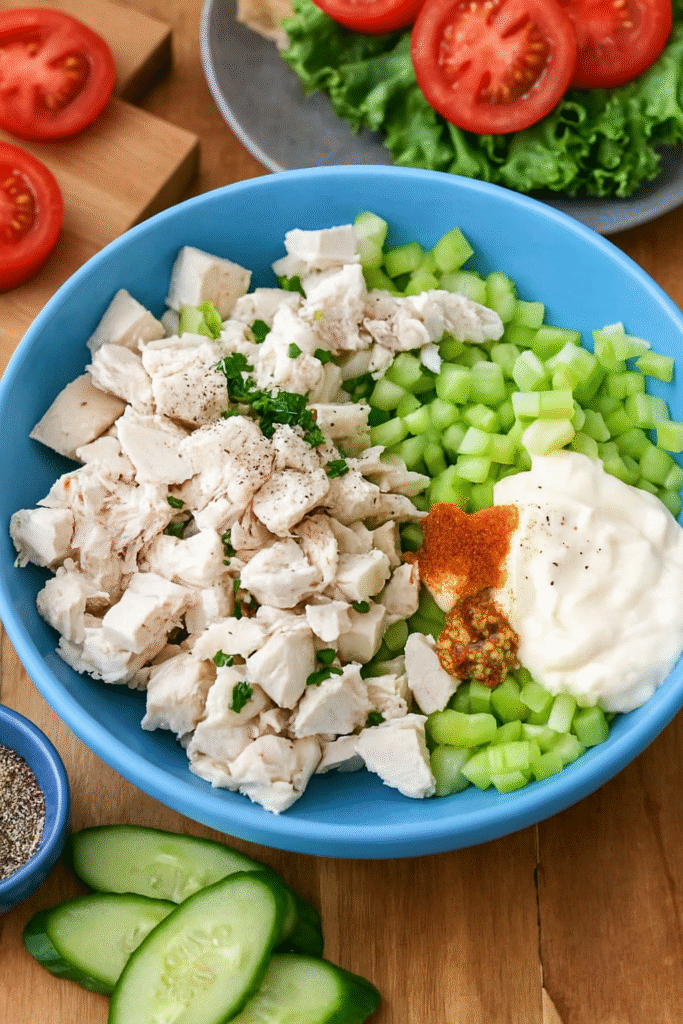
Free-Range vs. Conventional Options
Free-range chicken is often preferred for its richer flavor profile and better texture. In contrast, conventional chicken can be a more budget-friendly option without compromising too much on taste. For a more exotic twist, consider exploring recipes like the Quinoa Salad, which can complement chicken salad nicely.
Dark Meat vs. White Meat Considerations
The choice between dark meat and white meat chicken depends on personal preference. Dark meat tends to be juicier and more flavorful, while white meat is leaner and can provide a milder taste.
Fresh Produce Components
Fresh produce adds texture, flavor, and nutrients to the chicken salad. Common components include celery, onions, and herbs like parsley or dill. For example, using 1 rib of celery, diced, and 1 green onion, thinly sliced, can add a nice crunch and freshness to the salad.
Dressing and Seasoning Options
The dressing can make or break a chicken salad. Mayonnaise is a classic choice, providing creaminess and richness. For a lighter version, consider using Greek yogurt or a vinaigrette. Seasoning with salt, pepper, and herbs can enhance the overall flavor. A typical ratio could be ½ cup of mayonnaise to 2 cups of cooked, chopped chicken.
By carefully selecting the chicken, fresh produce, and dressing, you can create a chicken salad that is not only delicious but also nutritious and visually appealing.
Equipment Needed for Preparation
Preparing chicken salad requires more than just ingredients; it demands the right equipment to ensure efficiency and ease. Having the appropriate tools not only simplifies the preparation process but also enhances the overall quality of the dish.
Kitchen Tools for Efficiency
To efficiently prepare chicken salad, several basic kitchen tools are essential. A large mixing bowl is necessary for combining ingredients. Mixing Bowls come in various sizes, and having a few different sizes can be helpful. A sharp knife and a cutting board are also crucial for chopping ingredients like vegetables and herbs. For more information on preparing other dishes that require similar tools, you can visit this culinary resource.
Optional Specialized Equipment
While basic kitchen tools are sufficient for making chicken salad, some specialized equipment can further simplify the process. A food processor can be useful for chopping ingredients quickly and evenly. Additionally, a salad spinner can help dry washed greens, ensuring the salad doesn’t become too soggy. These tools, while not necessary, can enhance the preparation experience and the final product’s quality.
By equipping your kitchen with the right tools, you’ll be well-prepared to make a delicious chicken salad with ease.
Preparing the Chicken: Cooking Methods Compared
The foundation of a great chicken salad lies in the cooking method used for the chicken. Different cooking techniques can significantly impact the flavor, texture, and overall quality of the salad.
Poaching for Maximum Tenderness
Poaching is a moist-heat cooking method that involves submerging the chicken in liquid (usually water or broth) at a low temperature. This technique is renowned for producing tender and juicy chicken. To poach chicken, simply place it in a pot of simmering water or broth, cover, and let it cook until it reaches an internal temperature of 165°F (74°C). Poaching helps retain the chicken’s natural flavors and keeps it moist.
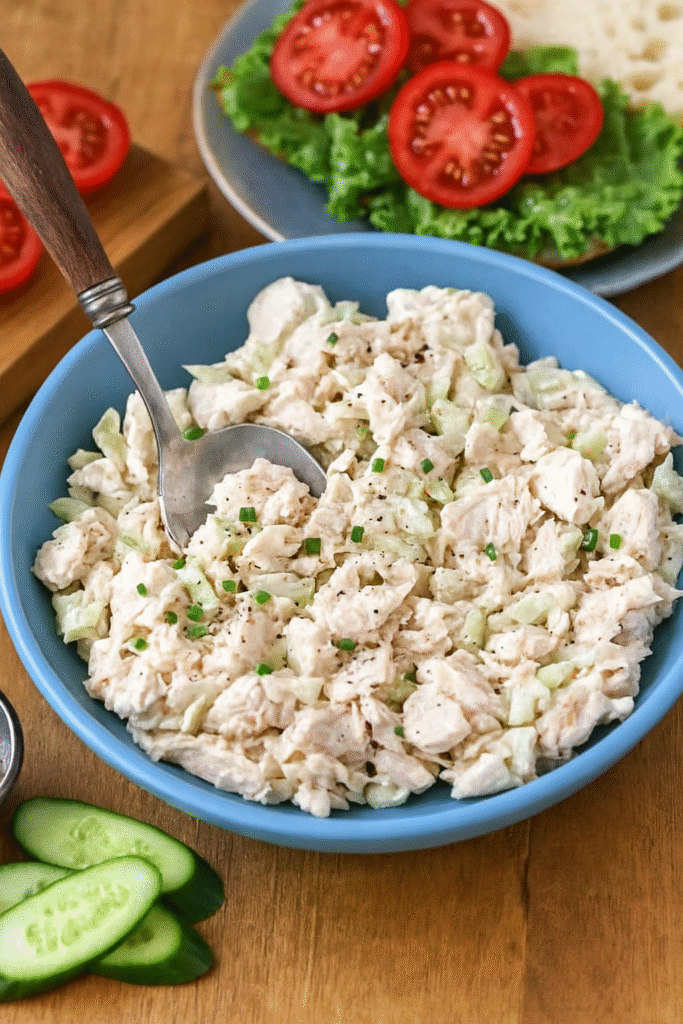
Roasting for Enhanced Flavor
Roasting chicken is a dry-heat cooking method that involves cooking the chicken in the oven. This technique brings out a rich, caramelized flavor on the outside while keeping the inside juicy. To roast chicken, preheat your oven to 425°F (220°C), season the chicken as desired, and roast until it reaches an internal temperature of 165°F (74°C). Roasting adds a depth of flavor that can elevate your chicken salad.
Time-Saving Alternatives
For those short on time, there are several alternatives to cooking chicken from scratch. Two convenient options are using store-bought rotisserie chicken and pressure cooker techniques.
Store-Bought Rotisserie Chicken Tips
Using a store-bought rotisserie chicken can save a significant amount of time. When selecting a rotisserie chicken, look for one that is freshly cooked and has a good color. You can also check out recipes like gratin de pâtes for inspiration on using rotisserie chicken in other dishes.
Pressure Cooker Techniques
A pressure cooker can drastically reduce the cooking time for chicken. Simply season the chicken, place it in the pressure cooker with some liquid, and cook according to the manufacturer’s instructions. Pressure cooking helps retain moisture and flavor, making it an excellent method for preparing chicken for salad.
Step-by-Step Classic Chicken Salad Recipe
A well-crafted chicken salad is a staple in many cuisines, offering a delicious way to enjoy protein, vegetables, and dressing in harmony. This classic chicken salad recipe is not only easy to make but also versatile, allowing for various customizations to suit different tastes.
Preparing the Base Ingredients
The foundation of a great chicken salad lies in its base ingredients. Start by selecting high-quality chicken breast or thighs, depending on your preference. Poaching or roasting the chicken are recommended methods to achieve tender and flavorful results. For a basic recipe, you’ll also need celery, green onions, and fresh herbs like dill or parsley.
To prepare the chicken, follow the cooking method of your choice, ensuring it’s cooked through and then cooled. Chop the celery and green onions finely, and pick the fresh herbs leaves for added freshness.
Mixing the Perfect Dressing
The dressing is what brings all the ingredients together, adding creaminess and flavor. For a classic chicken salad, mayonnaise is the primary dressing component. You can also add a touch of mustard for an extra layer of flavor and a squeeze of lemon juice for brightness.
In a small bowl, whisk together mayonnaise, Dijon mustard, salt, and pepper until smooth. Taste and adjust the seasoning as needed. For a lighter dressing, you can mix in some Greek yogurt or sour cream.
Combining Components for Ideal Texture
Combining the chicken, chopped vegetables, and dressing is where the magic happens. In a medium bowl, add the cooled chicken, chopped celery, green onions, and fresh herbs. Pour the prepared dressing over these ingredients.
Proper Chopping Techniques
To achieve the ideal texture, it’s crucial to chop the ingredients properly. Use a sharp knife to chop the celery and green onions into small, uniform pieces. This ensures that each bite has a balanced mix of flavors and textures.
Achieving the Right Consistency
Mix all the ingredients gently until they are just combined. The chicken salad should be creamy but not soggy. If it’s too dry, add a bit more mayonnaise or dressing. If it’s too wet, refrigerate for about 30 minutes to allow the flavors to meld together and the salad to firm up.
- Use fresh and high-quality ingredients for the best flavor.
- Adjust the dressing according to your taste preferences.
- Refrigerate the salad for at least 30 minutes before serving to enhance the flavors.
Nutritional Profile and Health Benefits
Delving into the nutritional aspects of chicken salad reveals its potential as a healthy and satisfying meal option. Chicken salad, when prepared with wholesome ingredients, offers a nutrient-rich profile that can contribute to a balanced diet.
Macronutrient Breakdown
A typical serving of chicken salad contains approximately 206 calories, with a macronutrient breakdown that includes 1g of carbohydrates, 15g of protein, and 16g of fat. The protein content is particularly noteworthy as it supports muscle health and satisfaction. The fat content, while significant, includes only 3g of saturated fat, making it a relatively balanced choice.
The presence of 15g of protein per serving is especially beneficial for individuals looking to increase their protein intake, such as athletes or those on a high-protein diet. Moreover, the relatively low carbohydrate content makes it suitable for low-carb dietary plans.
Vitamins and Minerals
Beyond its macronutrient profile, chicken salad is also a source of various vitamins and minerals. The presence of chicken as the main ingredient provides a good amount of essential nutrients like vitamin B6 and niacin. Additionally, depending on the vegetables and herbs used, chicken salad can be a good source of vitamin C, potassium, and other minerals.
As noted by nutrition experts, “A well-prepared chicken salad can be a nutritious and flavorful way to include essential vitamins and minerals in one’s diet.” The nutritional benefits are further enhanced when the salad includes a variety of colorful vegetables, which contribute antioxidants and fiber.
With 362mg of sodium and 48mg of cholesterol, it’s essential to consume chicken salad in moderation, especially for individuals with specific dietary restrictions or health conditions. Nonetheless, when prepared thoughtfully, chicken salad can be a healthy and enjoyable part of a balanced meal plan.
Regional Variations Across France
Regional France is a gastronomic paradise, with chicken salad being a dish that beautifully encapsulates the diversity of French cuisine. The country’s varied landscapes and cultural influences have given rise to a multitude of chicken salad recipes, each reflecting the unique characteristics of its region.
Northern French Interpretations
Northern France, with its rich history and cultural heritage, brings a distinct flavor to chicken salad. The region’s proximity to the North Sea and its agricultural practices have shaped the ingredients used in its chicken salads. Potatoes, apples, and fresh herbs are commonly incorporated, adding a delightful twist to the classic recipe.
- Use of locally sourced ingredients
- Incorporation of potatoes for added texture
- Fresh herbs for a burst of flavor
Mediterranean Influences in Southern France
The Mediterranean coast of France brings a different set of flavors to chicken salad, heavily influenced by the region’s olive groves, sun-kissed tomatoes, and fragrant herbs. Provençal herbs like thyme and rosemary, along with olives and sun-dried tomatoes, create a salad that is both refreshing and flavorful.
- Olive oil-based dressings
- Inclusion of olives and sun-dried tomatoes
- Use of fresh, fragrant herbs
Modern French Fusion Approaches
Modern French cuisine is not afraid to innovate and experiment, and chicken salad is no exception. Contemporary chefs are fusing traditional French techniques with international flavors, creating unique and exciting variations.
Examples include incorporating Asian spices, using exotic fruits, and adding nuts for crunch. These modern twists not only pay homage to the classic recipe but also push the boundaries of culinary creativity.
Creative Serving Suggestions
Chicken salad is more than just a dish; it’s an experience waiting to be crafted. Whether you’re hosting a dinner party or simply looking to elevate your lunch game, the way you serve your chicken salad can make all the difference.
Elegant Plating Techniques
To present your chicken salad elegantly, consider using a bed of fresh greens or a crisp lettuce leaf as a base. Garnish with edible flowers or herbs like parsley or dill to add a pop of color and freshness. For a more rustic look, serve the chicken salad on toasted bread or crackers.
Accompaniments and Pairings
The right accompaniments can enhance the flavor and texture of your chicken salad. Consider pairing it with complementary ingredients.
French Bread and Pastry Pairings
For a classic French-inspired meal, serve your chicken salad with a crusty baguette or a flaky croissant. The buttery flavor of the pastry pairs beautifully with the creamy chicken salad.
Wine and Beverage Recommendations
A dry white wine, such as Sauvignon Blanc or Chardonnay, complements the flavors of chicken salad nicely. For a non-alcoholic option, consider serving it with a refreshing glass of lemonade or iced tea.
These serving suggestions will help you turn a simple chicken salad into a memorable dining experience.
Storage and Make-Ahead Tips
The key to enjoying your chicken salad over several days lies in effective storage and preparation planning. Proper storage not only maintains the quality of the salad but also ensures food safety.
Proper Refrigeration Methods
To store chicken salad safely, it’s crucial to refrigerate it promptly. Store the salad in an airtight container in the fridge, where it can be kept for up to 5 days. Always check the salad for any signs of spoilage before consuming it, even if it’s within the storage timeframe.
When refrigerating, keep the chicken salad away from strong-smelling foods, as it can absorb odors easily. Labeling the container with the date can help you keep track of how long it has been stored.
Freezing Possibilities and Limitations
While it’s technically possible to freeze chicken salad, the texture and consistency may change upon thawing, particularly if the salad contains mayonnaise or other emulsified dressings. If you plan to freeze, it’s best to do so without the dressing and add it fresh after thawing.
Freezing is not generally recommended for chicken salads with delicate herbs or high water content ingredients, as these can become unpalatable when thawed. However, if you need to store it for a longer period, freezing is an option. Use airtight, freezer-safe containers and consume within 3 months for the best quality.
By following these storage and make-ahead tips, you can enjoy your chicken salad while maintaining its freshness and safety.
Common Mistakes to Avoid When Making Chicken Salad
The art of crafting the perfect chicken salad lies in avoiding a few critical errors that can compromise its overall quality. While it may seem like a simple dish to prepare, chicken salad requires attention to detail to achieve the ideal balance of texture and flavor.
Texture and Moisture Issues
One of the most common mistakes when making chicken salad is related to texture and moisture. Overcooking the chicken can lead to dryness, while underseasoning can result in a lackluster flavor. To avoid these issues, it’s crucial to cook the chicken just until it reaches the safe internal temperature, then let it rest before chopping.
Another texture-related mistake is not balancing the components. Too much mayonnaise can make the salad overly soggy, while too little can leave it dry. The key is finding the right balance that coats the chicken and vegetables without overwhelming them.
- Use freshly cooked or properly stored cooked chicken.
- Avoid overmixing the salad, as it can lead to a mushy texture.
- Balance wet and dry ingredients to achieve the desired consistency.
Flavor Balance Challenges
Achieving the perfect flavor balance is another challenge when making chicken salad. Overreliance on a single seasoning or ingredient can lead to an unbalanced taste. To avoid this, it’s essential to use a variety of herbs, spices, and other seasonings to create depth.
“The key to a great chicken salad is layering flavors,” says culinary expert Jacques Pépin. “You want to taste the chicken, the herbs, and the dressing all coming together in harmony.”
To enhance flavor, consider adding ingredients like diced onions, celery, or fresh herbs such as parsley or dill. Additionally, a squeeze of fresh lemon juice can brighten the flavors and add a refreshing touch.
- Start with a neutral base, such as plain cooked chicken.
- Add layers of flavor with herbs, spices, and other seasonings.
- Taste and adjust seasoning as you go to achieve the perfect balance.
Variations of the Classic Chicken Salad Recipe
Transform the humble chicken salad into a gourmet delight with these creative variations. The classic chicken salad recipe serves as a versatile canvas, allowing for a myriad of interpretations that cater to diverse tastes and culinary traditions.
Herb-Infused Versions
Infusing chicken salad with fresh herbs can elevate its flavor profile significantly. Consider adding chopped fresh herbs like parsley, dill, or tarragon to create a refreshing twist. For instance, mixing in 2 tablespoons of chopped fresh tarragon with your chicken salad can add a subtle anise flavor, enhancing the overall taste experience.
Fruit and Nut Additions
Incorporating fruits and nuts into your chicken salad can add texture and depth. Optional additions include 1 cup of chopped red grapes or 1 cup of chopped peeled apple, and 2 tablespoons of chopped nuts such as pecans or almonds. These ingredients not only enhance the flavor but also provide a satisfying crunch.
- Chopped apples add a sweet and crunchy texture.
- Red grapes provide a burst of juicy sweetness.
- Pecans or almonds contribute a rich, nutty flavor.
International Flavor Profiles
Exploring international flavors can give chicken salad a unique twist. From Asian-inspired adaptations to Mediterranean twists, the possibilities are vast.
Asian-Inspired Adaptations
For an Asian-inspired chicken salad, consider adding ingredients like soy sauce, ginger, and sesame seeds. These flavors combine to create a dish that is both familiar and exotic. Soy sauce adds a salty, umami taste, while ginger provides a spicy kick.
Mediterranean Twists
Mediterranean-inspired chicken salad can include ingredients such as olives, artichoke hearts, and feta cheese. These additions bring the flavors of the Mediterranean to your table, with the olives and feta cheese adding salty, savory notes.
Chef’s Expert Tips for Elevating Your Chicken Salad
With the right approach, a humble chicken salad can become a gourmet delight. Chefs have shared their expert tips to help elevate this classic dish, focusing on both flavor and presentation.
Professional Flavor-Enhancing Techniques
To enhance the flavor of your chicken salad, consider incorporating fresh herbs like tarragon or parsley. These add a bright, freshness that complements the richness of the chicken.
Another technique is to use a variety of textures, such as crunchy elements from nuts or seeds, to add depth to the salad. Toasted almonds or walnuts can provide a satisfying crunch.
- Experiment with different dressing ingredients, like truffle oil or infused vinegars, to add complexity.
- Don’t be afraid to mix in some fruit, like apples or grapes, for a sweet contrast.
- Use high-quality chicken as the base to ensure the best flavor.
Presentation Secrets from Culinary Experts
Presentation is key to making your chicken salad visually appealing. Start by choosing a colorful base, such as a bed of mixed greens or a vibrant plate.
Garnishes can also elevate the presentation. Consider using edible flowers or fresh herbs to add pops of color and freshness.
- Use a ring mold to create a neat, compact salad.
- Garnish with toasted nuts or seeds for added texture.
- Pay attention to the height of your salad by layering ingredients.
By incorporating these expert tips, you can transform your chicken salad into a dish that’s both delicious and visually stunning.
The classic chicken salad recipe is a timeless dish that has been enjoyed for centuries, with its rich history and versatility making it a staple in many cuisines, particularly in France.
By following the steps outlined in this article, you can create a delicious and healthy chicken salad that suits your taste preferences, whether you’re looking for a simple snack or an elegant dish for a dinner party.
Feel free to experiment with different ingredients and variations, such as herb-infused versions or international flavor profiles, to make the recipe your own and enjoy the numerous benefits of this classic Chicken Salad Recipe.
FAQ
What type of chicken is best for chicken salad?
The best chicken for chicken salad is cooked, boneless, and skinless chicken breast or thighs, with poached or roasted chicken being popular options for their tender and flavorful results.
How do I keep my chicken salad from becoming too dry?
To prevent dryness, ensure you’re not overcooking the chicken, and use a dressing that’s not too thin. Adding ingredients like celery, onion, or herbs can also help maintain moisture.
Can I make chicken salad ahead of time?
Yes, chicken salad can be made ahead of time. Store it in an airtight container in the refrigerator for up to a day. Give it a good stir before serving.
What are some creative ways to serve chicken salad?
Chicken salad can be served on a bed of greens, on toasted bread, or as a filling in sandwiches, wraps, or pastry. You can also get creative with toppings and accompaniments like nuts, fruits, or pickles.
How can I enhance the flavor of my chicken salad?
To enhance flavor, consider adding fresh herbs like parsley, dill, or tarragon, or spices like paprika or cayenne pepper. You can also experiment with different types of dressing, such as mayonnaise, Greek yogurt, or vinaigrette.
Can I freeze chicken salad?
Freezing chicken salad is not generally recommended, as the texture and consistency may be affected. However, if you must freeze it, do so in an airtight container and consume within a month. Thaw in the refrigerator and stir well before serving.
What are some common mistakes to avoid when making chicken salad?
Common mistakes include overcooking the chicken, using too much or too little dressing, and not balancing flavors. Also, be mindful of the texture by not over-chopping ingredients.
How can I make my chicken salad more nutritious?
To make a healthier chicken salad, use lean protein, plenty of vegetables, and a light dressing. You can also add nuts or seeds for crunch and extra nutrition.
What are some regional variations of chicken salad I can try?
You can explore different regional variations like the Southern-style with pecans and grapes, or the Mediterranean version with olives and feta. Experimenting with local ingredients and flavors can also lead to unique variations.
How do I achieve the perfect texture in my chicken salad?
Achieving the perfect texture involves balancing the size of the chicken pieces, the creaminess of the dressing, and the crunch from added ingredients like celery or nuts. Adjust these elements to your liking.
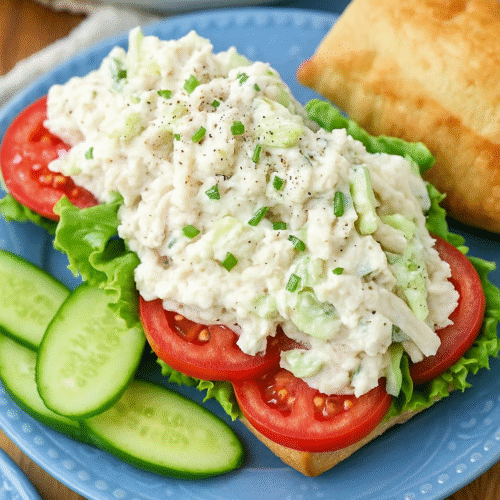
Classic Chicken Salad
Ingredients
- 2 cups cooked chopped or shredded chicken
- ½ cup mayonnaise
- 1 rib celery diced
- 1 green onion thinly sliced
- 1 teaspoon Dijon mustard
- ¼ teaspoon seasoned salt more to taste
- ⅛ teaspoon black pepper or to taste
- 1 teaspoon chopped fresh dill or ¼ teaspoon dried dill optional
Instructions
- In a medium bowl, combine the chicken, mayonnaise, celery, green onion, mustard, salt, pepper, and dill (if using). Mix well to combine.
- Taste and season with additional salt and pepper if desired.
- Serve as a sandwich or over salad.
- Optional Additions:
- 1 cup chopped red grapes or 1 cup chopped peeled apple
- 2 tablespoons chopped nuts (pecans or almonds)
Notes
- Calories: 206
- Carbohydrates: 1g
- Protein: 15g
- Fat: 16g
- Saturated Fat: 3g
- Cholesterol: 48mg
- Sodium: 362mg
- Potassium: 137mg
- Fiber: 1g
- Sugar: 1g
- Vitamin A: 72IU
- Vitamin C: 1mg
- Calcium: 10mg
- Iron: 1mg

